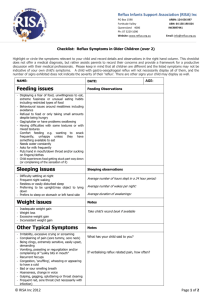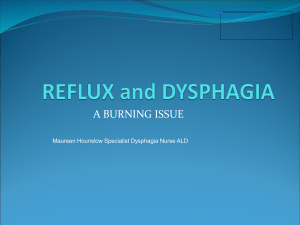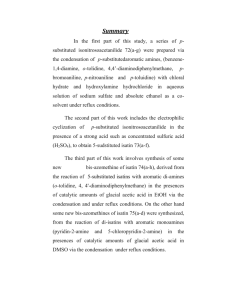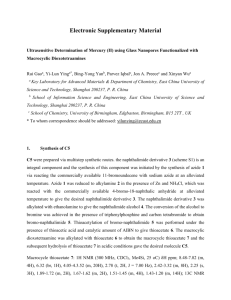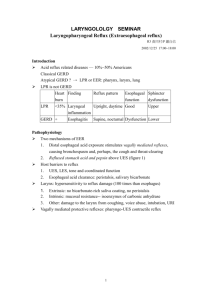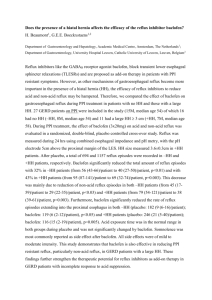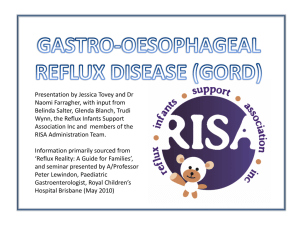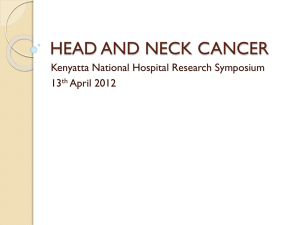The role of surgery in the modern management of
advertisement
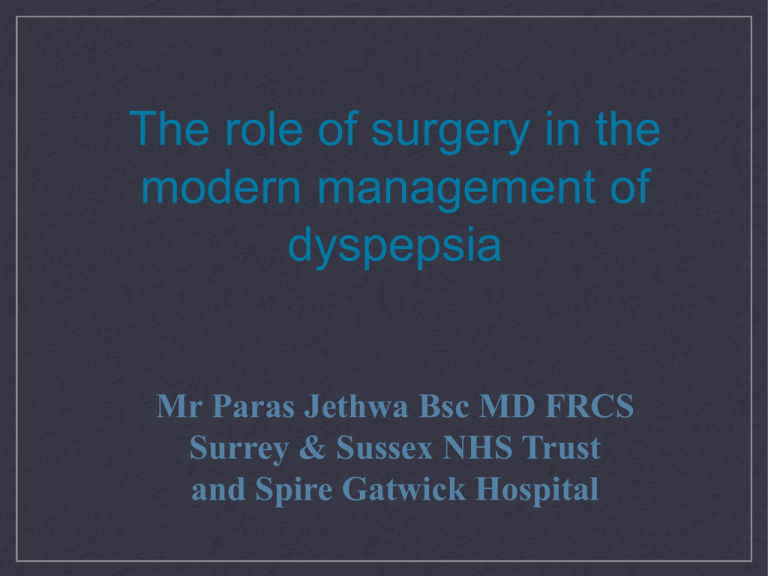
The role of surgery in the modern management of dyspepsia Mr Paras Jethwa Bsc MD FRCS Surrey & Sussex NHS Trust and Spire Gatwick Hospital GORD Very significant modern disease High prevalence and incidence Substantial drug budget Variable prescribing rationale (everyone in hospital) Correlation with obesity, diet, alcohol, coffee etc.... Mechanics of reflux Treatment Options • Lifestyle (smoking.red wine, obesity) • PRN Antacids • PRN PPI • Regular PPI (?BD ?Nexium) • OGD (or sooner if red flag) • Addition of antacid for breakthrough (Gaviscon Advanced) • Addition of ranitidine for nocturnal symptoms • ? Surgery - refer for pH/manometry ➡significant number were mis-referred ➡(i.e should have been urgent) ➡2% incidence of OG cancer ➡98% sensitive Barrett’s Intestinal Metaplasia • Both endoscopic and histological diagnosis • Caused principally by uncontrolled acid reflux • Confers an increased risk of oesophageal cancer of 30-120x • Rapidly rising incidence • Oesophageal Cancer 5th commonest cause of cancer mortality in the UK Current treatment • • Treatment dose of a PPI Consider NSAIDs/ Aspirin • Surveillance • Duration • Interval • Aneuploidy/tetraploidy • Anti reflux surgery Oesophagectomy for HGD or Cancer • Surveillance limitations • Surveillance probably doesn't work • Time consuming, inaccurate, distressing for patients, expensive • Lack of an easily identifiable high risk group? Current risk markers • High Grade Dysplasia: – – Patchy and easily missed On average HGD occupies only • • 1.3cm2/ 32cm2 of Barrett’s Variable Future Cancer risk: – – 13-59% develop Cancer within 5 years 40% of cancer patients not found to have prior HGD • Aneuploidy: – If no HGD or aneuploidy tiny risk (approaching 0%) of developing cancer in next 5 yrs (87% of patients) – If aneuploidy risk of 38% – If aneuploidy and HGD risk is 66% • Panel of biomarkers: – Ultimately this will be the answer – Still in research setting Long term effects of GORD PEPTIC STRICTURE Anti reflux procedures • UK lags behind Australia and South Africa • • • • Determined by healthcare funding(?) Poorly accepted by some gastroenterologists Perception of a high risk/limited procedure May be underused in high risk groups and in younger patients • Can offer a significant improvement in QoL Surgical correction R CRUS L CRUS OESOPHAGUS Effect of operation Who should you consider referring? Clear indication: Poorly controlled symptoms Hiatus hernia causing dysphagia +/- reflux Young patients with IM/marked oesophagitis Intolerant of conventional therapy Mass reflux Respiratory compromise Probably not for: Reasonable control with occasional flare-ups Cost of therapy Drug Dose Cost (£, 28 days) Annual(£) Omeprazole 20mg 28.56 571.2 Lansoprazole 30mg £23.75 712.5 Pantoprazole 40mg £23.65 946 Rabeprazole 20mg £22.75 455 Esomeprazole 20mg £18.50 370 Esomeprazole 40mg £28.56 1142.4 Is it cost effective? (1) The REFLUX Trial (first reported in BMJ 2009) • “The effectiveness and cost-effectiveness of minimal access surgery amongst people with gastro-oesophageal reflux disease - a UK collaborative study”. • • • But - need to add cost of testing (OGD/pH/manometry) & loss of work etc. Significant QOL improvement at 12 months+ (SF36) • • Mean cost of Surgery: £2000 - £4000 (2) Systemic review 2011 Surg endoscopy Thijssen et al. • Four publications were suitable, Jan 1990 to 2010 • • • Surgery more expensive in n=3; Better QALY in n-=2, fewer symptoms n=1 C.E. - inconclusive - slight improvement in QALY • (3) Fundoplication vs medical management in adults for GORD - Cochrane review 2010 • • Significant improved QOL in surgical group • • Four trials elligible n=1232 % of patients have post op dysphagia Surgery risk uncommon but not without it’s risk Cost greater - based on 1st year of treatment only. • • Need to consider the long term effect of GORD Summary • Improved QOL/QALY • but ££ at one year • Surgical considerations BMI <35 (men store fat at GOJ) woman up to 40 (Similar area to LAGB placement) Reasonable health/respiratory compromise No major motility issues (HRM/Ba swallow) Hiatus hernia/OGD proven reflux without pH studies Psychological onlay/effect of dietary change Physiological studies pH Studies Only method of objectively proving reflux In cases of odd symptoms/symptom correlation Pre/Post operative comparison Medico legal aspects Bravo or conventional systems Results of surgery • Three types of wrap commonly performed: • 180< 270 < 360 • Progressively better but increase risk of dysphagia & gas bloating • Tension free wrap with good crural closure • >85% report major improvement at 5 years • pH retesting - no one with abnormal profile • Not uncommon to return to some medication Complications & SE • Dysphagia - acute revision • Gas bloating • GI dysmotility (non vagal) • Recurrent symptoms • Injury (GOJ/vagus/spleen/other) Advanced technique presented in Europe and UK Largest series of mesh reinforced hiatal closures Common practice at ESH/Spire Advances • Improved training & simulation • Emphasis on dedicated laparoscopic service • Improvement in HD systems/integrated theatre • Anaesthesia and pain control • Improved instrumentation • Enhanced recovery protocols • 3D laparoscopy/robots/NOTES/SILS Very latest laparoscopic facilities and optics. SASH recognised as a high quality training centre amongst KSS trainees Links to Imperial College The role of surgery in the modern management of dyspepsia Mr Paras Jethwa Bsc MD FRCS Surrey & Sussex NHS Trust and Spire Gatwick Hospital
